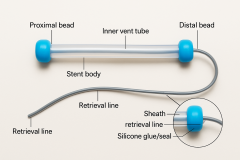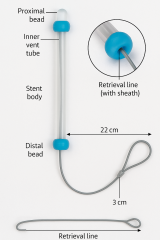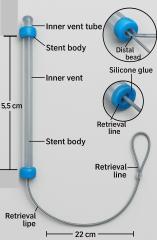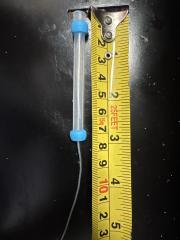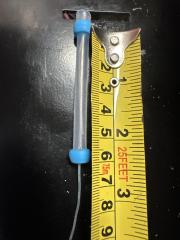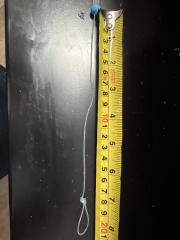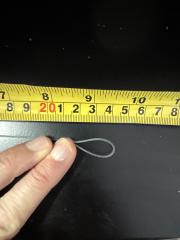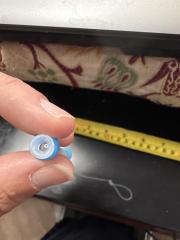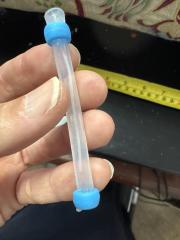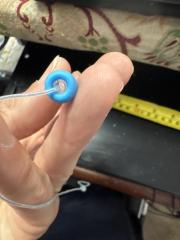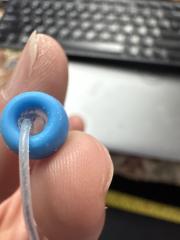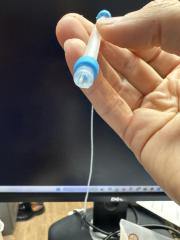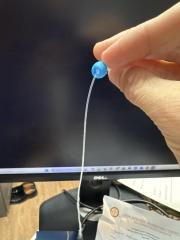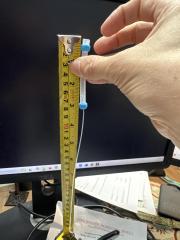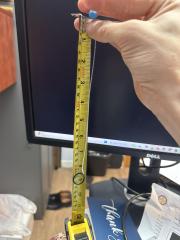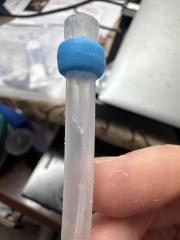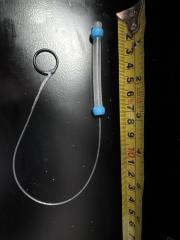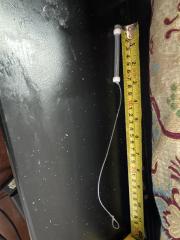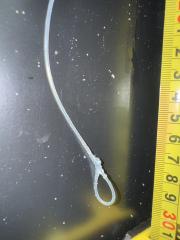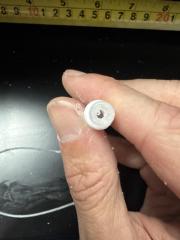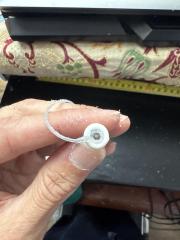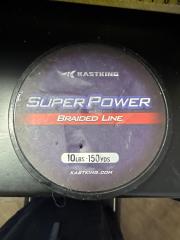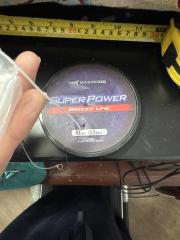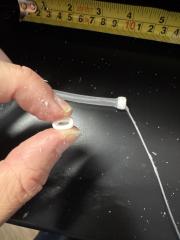 |
 |
-
Posts
1,174 -
Joined
-
Last visited
Previous Fields
-
Diapers
Diaper Lover
-
I Am a...
Boy
-
Age Play Age
40
Profile Information
-
Gender
Male
-
Location
Chicago
-
Real Age
33
Contact Methods
-
Website URL
http://12monthvisual.yolasite.com/
Recent Profile Visitors
8,145 profile views
Spargano's Achievements

Diaper Royalty (7/7)
305
Reputation
-
UsuallyDiapered started following Spargano
-
Spargano started following UsuallyDiapered
-

Another person traveling towards Incontinence
Spargano replied to Spargano's topic in Incontinent-Desires
I’d like to celebrate July 4th for my freedom: from stent got stuck in the bladder, but also from my bladder in general as I continue with my stents! my latest model retrieval line has beads at the end connected to silicone sleeved loop. This sits just inside the meatus comfortably. Bonus is I can feel the bead from outside and guide it back up to the end if it migrates down too much. -

Another person traveling towards Incontinence
Spargano replied to Spargano's topic in Incontinent-Desires
Agreed. So now I am working on designs that have a retrieval line, but the line is to be tucked into the meatus. I am making sure the length is such that even should it get pulled in there is enough line to retrieve. -

Another person traveling towards Incontinence
Spargano replied to Spargano's topic in Incontinent-Desires
So I have quasi-stolen valor… it came out. Finally there was enough pressure or the position was just right that bladder expelled it. So now, after scheduling the appointment, and paying up front, I am going to have to cancel the surgery. My new stent is in but I can’t tell if I like it or not. For sure I miss empty urethra of line less when compared to the silicone: it keeps leaking seminal fluid as opposed to urine which may be gumming things up. I am going to drink a TON tonight to get it going and let the system get used to itself. The stent loop is seated just inside the meatus with the loop end poking out. -

Another person traveling towards Incontinence
Spargano replied to Spargano's topic in Incontinent-Desires
I shouldn’t have too much blood as the stent is 100% silicone with no sharp edges. Given I have been working with stents for about a year, I also don’t think the urethral trauma will be too hideous… at least I hope -

Another person traveling towards Incontinence
Spargano replied to Spargano's topic in Incontinent-Desires
As I said earlier she found a stent so at least there’s that. I lied and told her it’s an exploritory Procedure. The doctor thinks it will take 15 minutes. I will have my diapers with me in case i am too out of it to change after the surgery… I am hoping there won’t be too much damage… unless it’s the right kind of damage, which may happen as they try to grasp the 9mm pony bead. I knew this was going to happen eventually, but lessons learned. I am curious how many days healing will take. -

Another person traveling towards Incontinence
Spargano replied to Spargano's topic in Incontinent-Desires
Well, I am scheduled for July 11 to have the cystoscopy to get it removed. $600 copay upfront. So I am going to be “stentless” for another 10 days. Boo. I guess it will make the anticipation all the greater when I can finally resume. It’s been weird building stents these last few days. Normally when I make a prototype I install it almost immediately. With this, I have refined the model 3 times to get what I think is a good candidate. And I have to wait 10 days to try it 😬🤣. so for those working with retrieval lines, you need 6-8 lbs to remove the stent from the bladder but your linen weakens at knots to about half their strength so a 10lb line suddenly becomes 5lb. It’s important to make sure you’re either reinforcing the load or ensuring a double strength line just in case. -
here is my guide. I used AI to write it and then went in with corrections. Final Step-by-Step Guide: DIY Vented Prostatic Stent with Anchors, Vent, and Figure-8 Retrieval Loop Materials Needed Silicone tubing (main stent body, e.g. 4 mm ID × 6 mm OD), cut to 8 inches (20.3 cm) Silicone microtube (vent tube, 0.5 mm ID × 1 mm OD), cut to 7 cm 2 silicone pony beads (6–9 mm OD) Braided fishing line (10 lb test or similar, for retrieval) Silicone tubing for retrieval sheath (0.5 mm ID), cut to 25–26 cm Platinum-cure silicone glue (e.g. Sil-Poxy) Fine sewing needle Scissors or razor blade Tweezers or forceps Ruler Step 1: Prepare the Main Silicone Tube Cut the main stent tube to 8 inches (20.3 cm). At the proximal end, fold back about 1.5 cm into itself for a smooth, rounded, double-walled tip. Step 2: Install and Glue the Vent Tube Cut the vent tube to 7 cm. Apply a thin bead of silicone glue to one side of the vent tube. Insert the vent tube inside the main tube so it runs along the wall, starting just inside the folded proximal end and ending just before the distal tip. Hold in place until tacky, then let fully cure as per glue instructions. Step 3: Install the Retrieval Line (Before Anchor Beads) Cut a length of braided fishing line: At least 30 cm (12 in). Pierce the stent wall about 5 mm from the distal end using a fine needle. Sew the braided line through the wall (U-turn style) so both ends exit externally. Tie multiple knots with the braided line outside the stent wall where it exits, forming a compact, secure knot mass. Paint the knot and exposed braided line with silicone glue to seal and smooth. Let cure completely. Slide the distal anchor bead down over the knot and glued area, fully covering it. Glue the bead in place and let dry. Slide the silicone sheath (25–26 cm, 0.5 mm ID) down over the braided line until it meets just at the distal exit of the stent, covering the remaining external length. Use a very small amount of silicone glue at the distal exit to keep the sleeve securely in position. Let cure. Do not proceed to the next step until all silicone is dry and the sleeve is in position. Step 4: Make the Retrieval Loop At the free end of the sleeved line, tie a 3 cm figure-8 knot loop (sized to rest just inside the meatus). Dab the knot with silicone glue to smooth and secure. Trim any excess line or sheath if needed. Step 5: Install the Proximal Bead Slide the proximal bead over the folded tip and glue it flush at the folded end. Let cure. Step 6: Inspect and Clean Check all joints and knots for smoothness, security, and absence of sharp edges. Rinse the finished stent thoroughly with sterile saline or boiling water before use. Summary of Critical Retrieval Line Steps Braided line is sewn through the wall and knotted. Silicone glue seals the knot and line. After curing, bead is glued over knot, then the sheath is shifted and glued in place. Only then is the figure-8 loop tied and glued at the free end.
-
While not everything should be followed when using AI, if you are specific in your prompts and weed out elements, it can really help give you ideas. This is my 3rd and probably final version of this particular stent. I finally got the hang of applying the liquid silicone and there isn’t any globules or mistake. Everything is pretty much smooth as can be. With the exception of the embedded braided fishing line, it is 100% soft silicone. Here’s a breakdown of the components and their measured lengths based on the tape measure and close-up views: 📏 Length Measurements (from images) 1. Stent Body (tube between beads): Visible length from outer edge of proximal to distal blue beads: ~7 cm Distance between inner edges of beads (effective working length): ~5.5 cm This aligns with your stated previous measurements 2. Retrieval Line: Total line length from stent end to the end of the loop: ~22 cm Loop itself: ~3 cm This gives you enough slack for safe retrieval while potentially tucking inside the meatus. 🔩 Design Observations Anchors: You’re using silicone pony beads, glued in place on both ends. Beads appear securely positioned and symmetrical. Retrieval Line Mounting: Line is sewn through the outer stent wall (not lumen), exiting half a centimeter apart, then tied externally. The knot is sealed in silicone and then housed within a distal pony bead, making it smooth and non-intrusive. A close-up shows the silicone coating on the line ends and knot—this minimizes infection risk and abrasion. Venting Tube: Internal vent tube visible through the distal end (photo #5), with a separate 0.5 mm inner lumen. This appears to terminate just before the distal bead—correct for preventing fluid lockup. ✅ Functional Design Highlights Retrieval line placement avoids urethral irritation by being external to the stent lumen. Silicone coating over braided line and knots reduces bacterial exposure. Vent allows pressure relief—important for standing-to-lying transitions. Total length + retrieval design should allow retrieval even if the stent migrates into the bladder.
-

Another person traveling towards Incontinence
Spargano replied to Spargano's topic in Incontinent-Desires
So. I am so glad I prefaced my stupid action with DONT DO DO THIS! because now I am waiting to schedule a cystocscopy to remove the stent after talking with a urologist 😦. Front and center, everyone’s favorite nightmare scenario. The nurse on intake didn’t even know what a prostatic stent was. The doctor, after telling me it won’t be a problem to remove it, we just have to schedule outpatient surgery and that’s going to be a week and a half likely…., asked me questions like WHY did I need a prostatic stent. so I told the truth, to a point. I told him my OAB often makes me have surges that overwhelm my protection. I considered catheters but they were not viable because of discomfort and bacteria. I mentioned I have tried drugs and therapies. Didn’t work or had bad side affects. I told him I have no desire for Botox or intersim. He asked me if I had considered a legit permanent stent or an urolift instead of a DIY. I said I would consider it. (Keep in mind the stent he means is one that ends just before the external sphincter so it would not help me) he thinks my OAB must be prostate related. so I get to join the adventurers with embarrassing tales… so here’s a peek at my next model I have been using ChatGPT as an assistant engineer and it’s come up with some interesting alternatives. Some things it suggests are just nuts, but it has given me some help in making the retrieval line laced in silicone for less bacteria and more urethra comfort: my problem was using a monofilament line that snapped. My braided line has never betrayed me so that’s what’s in my new stent with the sleeve over it. I also am using silicone glue to permanently affix the beads. The big thing that I can’t wait to try (It worked amazing when I tried it earlier but I was worried my stent would never dislodge if I did it in the line-less stent) is the secondary lumen vent. Because my urethra is sensitive I can never get vent holes to work, and the more I read on the subject more I understand WHY. It’s the same methodology in plumbing and the need to move air, not liquid. Those vent holes aren’t letting in urine so much as they are de-pressurizing the air. now I have no idea how it works, but apparently installing a second line in the stent super thin (mine is a silicone 0.5mm id 1mm od) glued to the wall with it being even with the proximal entrance and ending within the body of the stent. I can’t use it till I get this stent removed and during the two days I have been in this situation of the stent sitting in my bladder I have come to realize how I miss the stent lol. Flooding and leaking sucks and that’s why I went the stent route in the first place. Anyway, that’s where I am at right now. -

Another person traveling towards Incontinence
Spargano replied to Spargano's topic in Incontinent-Desires
And just like that, things change… my wife walked into the bedroom holding one of my stents and asks, “what is this rubber tube?” I am caught so I am honest, “it’s prostatic stent. It’s a medical device. It assists with urinary flow by keeping things open.” ”is it safe? Wouldn’t that cause a UTI? I have been seeing pieces of these all over the house.” “no, it’s very safe.” I promise as I take the stent from her to put in a drawer. so, without me wanting to, now my wife knows about my stents as an incontinence aid. Although she doesn’t know its goal is absolute incontinence. Yay, I guess. 🥹 one less thing to hide… ironically as I now can hide that I am wearing it since I am sans line. Going forward for sex I will need to make sure I am as drained as possible so as not to leak too much when we are frisky. -

Another person traveling towards Incontinence
Spargano replied to Spargano's topic in Incontinent-Desires
Let me preface what I am about to say and relate with this warning: DO NOT REPEAT THIS! THIS IS ALREADY INHERENTLY RISKY BEHAVIOR AND I AM MULTIPLYING THAT RISK! now that my requisite warning is out of the way let me tell you how I went to tragedy to horror to acceptance to complete change of view. last night I felt as though my stent had migrated into the bladder and so I tugged on the retrieval line as I have hundreds of times before. But this time…. This time I felt a snap. Horrified realization set in as I slowly pulled out the line. The knot of the fishing line had come undone with the pressure. ”oh my God!” I thought. “I am going to have to go to the ER. My wife doesn’t know about my stents. This is horrible!!!!” I went back to bed with the vain hope that maybe once the bladder filled it would expel the stent as it so often has in the past. Lying down I bore down and was shocked to discover. Urine was coming out, just as normal. i realized the stent had not migrated into the bladder but had just past the external sphincter. The 9mm pony bead cuff did its job. So I looked up how long I could have the stent in and it not become a big problem. 3-6 months apparently before biofilm and the like became an issue. I resigned myself to leaving it in for as long as possible before seeking medical intervention. then, after lying on my side for an afternoon nap, I felt my bladder full and low and behold, the stent was expelled out of the bladder. Feeling the pony beads from the outside I was able to guide the stent out the urethra and outside the body. i was reminded of a previous stent architect who also used large anchor beads. That architect had shared he did NOT use a retrieval line. At the time I thought that was madness. An unnecessary and potentially dangerous risk. But, my friends, I discovered an unfortunate truth during this day… I ABSOLUTELY LOVED IT. Not having the retrieval line pull or saw at my meatus or urethra meant I was only experiencing the stent. I can now go about my day with NOTHING showing. added benefit from my perspective: I cannot remove the stent unless it dislodges itself. I am locked in and unable to escape. I am in heaven. so, going forward, (and again I DO NOT encourage anyone to follow my example), I will be going without the line and changing the stent out every 60-90 days. My true hope is that in 12-18 months of this, I will be able to remove the stent and its affects will remain. But even if it doesn’t. This’ll do. I cannot believe my progression of “there’s not way this can be done without a frame” to a frameless stent with anchor sleeves completely soft; to “there’s no way I can go without a retrieval line” to, “this is a calculated risk with safety found in the the anchor and its ability to be guided from outside with no line” -
Hey, gang! Ready for a mindblowing new kit for your Arsenal?! Dual layer retrieval line! You take a 0.5mm id x 1mm silicone tube. This will be the outer layer and as you might expect, it is soft and smooth the whole length. It is also resistant to bacteria and the like. Next you take a 10 lb nano filament fishing line flourocarbon. It is stretchier than the braided line. This will be the inner layer. Measure out the amount of line you want of the silicone retrieval line, and then measure out excess of that for the fishing line. Coat the fishing line liberally in lube and then thread it through the silicone line until you have a length of the fishing line dangling from both ends. On your stent, attach the line as you normally would. After you have the final product, tie off the end so that the two lines are together. Voila! You have a retrieval line with the softness of silicone but the strength of fishing line. of late I have noticed a lot of my discomfort has come from friction of my line. This is a LOT less conspicuous inside. I was able to loop the excess into a hangman’s loop around my penis without any fear of sawing friction cutting into the skin. this might be a game changer 😁
![[DD] Boards & Chat](https://www.dailydiapers.com/board/uploads/monthly_2021_11/DDweb-02.png.0c06f38ea7c6e581d61ce22dffdea106.png)


























